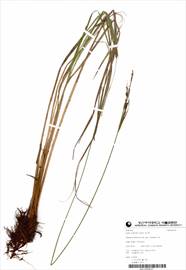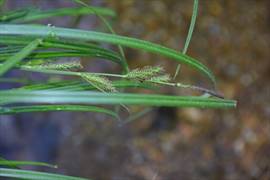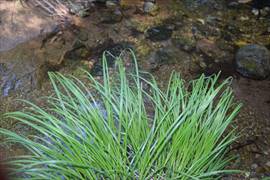Click on images to enlarge

Specimen

Carex forficula Franch. & Sav. 산뚝사초

Carex forficula Franch. & Sav. 산뚝사초
Scientific Name
Carex forficula Franch. & Sav. 산뚝사초
Subgenus classification
: Carex.
Habitats
Occurs in Gangwon, Seoul, Gyeonggi, Chungbuk, Chungnam, Gyeongbuk, Gyeongnam, Jeonbuk, Jeonnam or Jeju.
Stem
Clumped growth, with basal sheath color light brown, and length about 40-90 cm.
Leaves
Leaves longer than the stem or similar to the stem, have glabrous surfaces, width about 2.5-4 mm.
Inflorescence
The number of spikes two or more. Spike shapes different (showing distinct sexual characteristics), with all spikes unisexual, spikes arranged loosely. Terminal spike sexuality staminate. Lateral spike sexuality pistillate, and erect to ascend. Lateral spike length about 1.5-5 cm. Terminal spike length about 3-4 cm. Number of spikes per node one (one spike in one bract).
Bract
Lowermost bract shape leaf-like.
Glume
Staminate glume awn absent. Pistillate glume awn short (awn less than one-third of the total length). Pistillate glume color dark brown to blackish brown.
Perigynium
Transverse section lenticular to biconvex. Perigynium shape obovate (the broadest part near the apex) or elliptical to narrow elliptical (the broadest part in the center), and densely flowered. Perigynium glabrous (?) or hairy or pubescent. Beak long (beak more than one-third of the total length), thin (the beak is clearly distinguished from the perigynium, and the starting point of the beak is less than one-third of the widest part of the perigynium), with bidentate to bifid mouth. Length 3-4 mm.
Achene
Appendage absent, no constrictions.
Copyright © 2024. All rights reserved.
